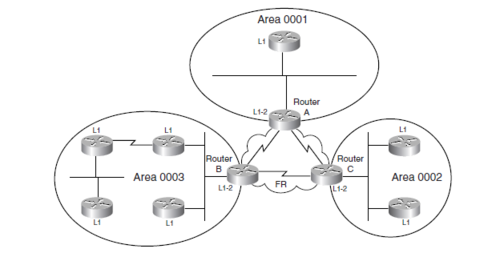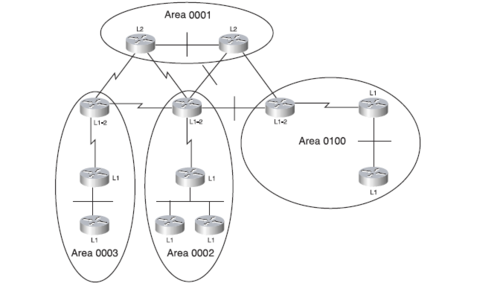IS-IS
Contents
Intermediate-System to Intermediate-System
IS-IS is a link state Routing protocol which are also used in IP network. Here it is called integrated IS-IS. IS-IS is often used by providers as an IGP.
Level 1 Routing
A level 1 Router only knows about the area in which it is located. Like a stub Router in OSPF. It has no knowledge of other areas. A level 1 Router only knows a default Route to the nearest level 2 Router if Routing between areas is necessary. Every Level 1 Router in that area has the same link State Database containing information about that area.
Level 1 Routers are referred to as Intra-area Routers
Level 2 Routing
A Level 2 Router routes between areas and are referred to as Backbone Routers. The backbone must be contiguous because all Level 2 Routers share the same Link-State Database which contain prefixes from all areas. If the backbone is fractured Routing information will not be the same on all Level 2 Routers.
Level 2 Routers are referred to as Inter-area Routers
Level 1-2 Routers
The Level 1-2 Router has both the Level 1 Link-state database containing information about the area in which it participates and Level 2 Link-state database containing information about all areas.
Point-to-point link Adjacencies
If a Point-to-Point link connects two Routers the Routers are neighbors and each side send a CSNP - Complete Sequence Number Packet - which is a packets containing the Link State database to each other.
Broadcast links Adjacencies
On broadcast link medias, for example Ethernet, all Routers receive receive LSP - link State packets - from one router the DIS - Designated Intermediate system. The DIS Router has the responsibility to flood LSP's to all connected IS-IS Routers on behalf of the pseudonode.
Pseudonode
The pseudonode is a virtual Router that represents the LAN. All IS-IS Routers participating on the LAN simulate an interface on the imaginary Router. This imaginary Router is called the pseudonode. The pseudonode floods LSP's to all participating Routers. In the real world it is the DIS who sends LSP packets. The DIS is elected from the priority on the interface which defaults to 64. If all priorities are the same the DIS is elected as having the highest SNPA (Data-link address)
Configuration
Example
interface Loopback0 ip address 192.168.100.12 255.255.255.255 ip router isis ! interface fastethernet 0/0 ip address 83.90.2.3 255.255.255.0 ip router isis ! router isis net 49.0000.1921.6810.0012.00 is-type level-2-only metric-style wide

